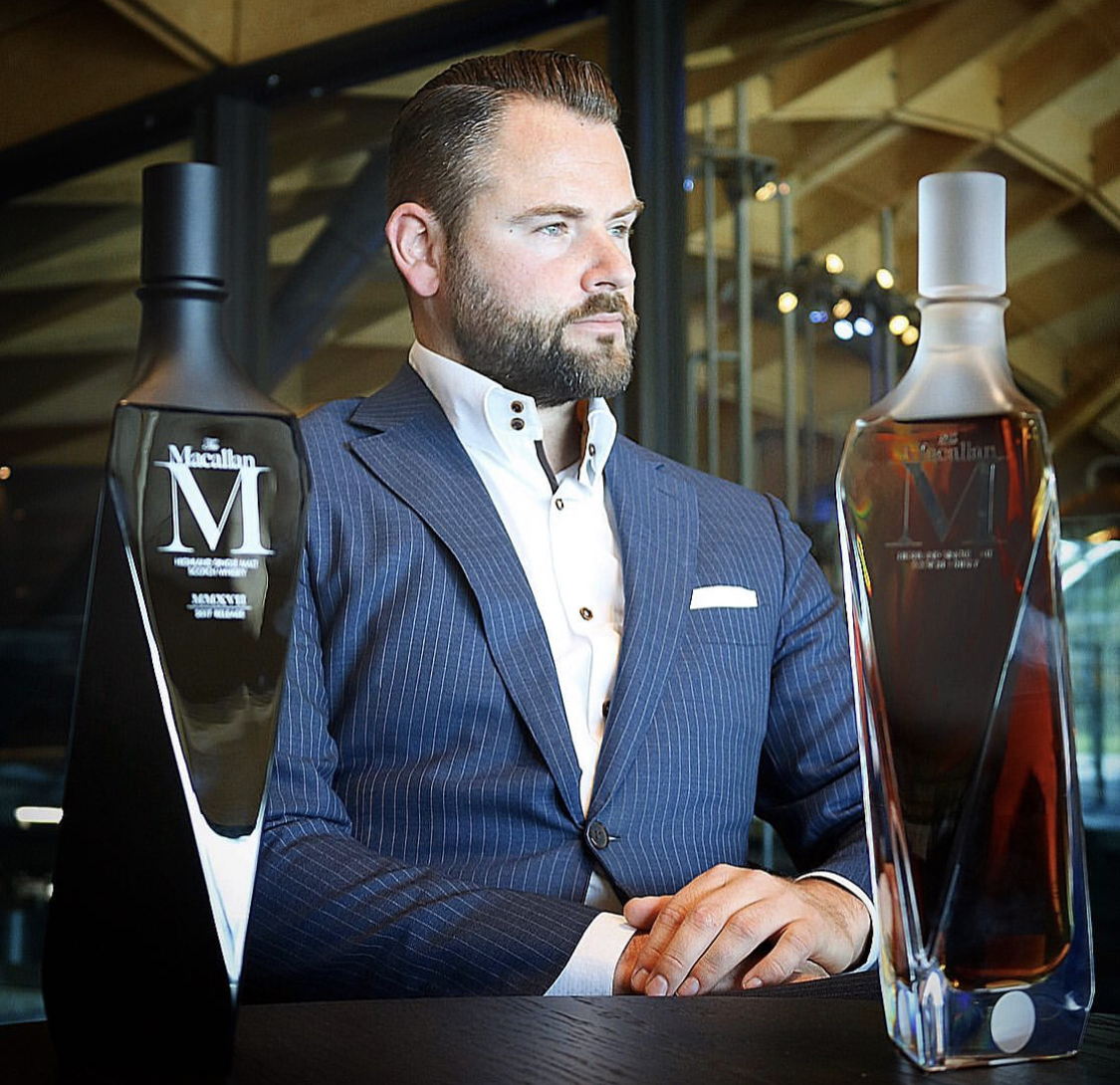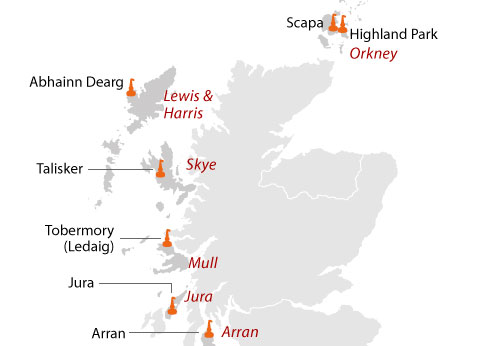Whisky regions in Scotland

Officially there are two regions in Scotland. This will be the highlands and the lowlands. But in the Scottisch whisky world we know six regions.
These are:
- Highlands
- Lowlands
- Speyside
- Islay
- Island
- Campbeltown
These six regions have a total of 130 operating distilleries in Scotland. The majority of these distilleries you will find in the Speyside region.
Highlands
Highland single malts are single malt Scotch whiskies produced in the Highland region of Scotland. This categorization includes the whiskies produced on the islands around the perimeter of Scotland (the Island single malts), except for Islay (see Islay whisky). Incongruously, the area also includes certain lowland areas in the North-East of the country such as Banffshire and Aberdeenshire.
The Highland whisky flavour is different from the other regions by having more silky floral notes, with strong peaty flavours complementing the dry oak and fruit cake finish, while their island counterparts have a common citrus and smoke aroma with brine, black pepper and honey competing for attention on the palate.
The Highlands contain these distilleries:
- Aberfeldy
- Arbikie
- Ardmore
- Ardnamurchan
- Balblair
- Ben Nevis
- Blair Athol
- Royal Brackla
- Clynelish
- Dalmore
- Deanston
- Deeside
- Dornoch
- Edradour
- Fettercairn
- Glencadam
- Glendronach
- Glen Garioch
- Glenglassaugh
- Glengoyne
- Glenmorangie
- Glen Ord
- Glenturret
- GlenWyvis
- Loch Lomond
- Royal Lochnagar
- Lone Wolf
- Macduff
- Nc’nean
- Oban
- Pulteney
- Strathearn
- Teaninich
- Tomatin
- Tullibardine
- Wolfburn


Lowlands
As a region, the Lowlands have been more strongly associated with grain whisky and blended whisky than malt whisky. Blended whisky often uses a high proportion of Lowland malt, as the less intense flavour profile means it does not dominate the other constituent whiskies.
In terms of Lowlands whisky flavour, the character of the malt often comes through strongly, with a soft body, according to another report. Traditionally the barley used has been unpeated, possibly because the Lowlands, East Lothian in particular, had a strong coal-mining industry.
Another review states that most of the region’s whiskies tend to be “lighter and grassier” without the “smoky” flavour produced by peat.
However, in recent years lowland distilleries such as Ailsa Bay and Annandale have become characterized by their use of peat, with a flavor profile more typical of Islay whiskey.
According to an August 2019 report, Auchentoshan is the region’s only distillery still making whisky that is triple distilled which leads to “an edge of citrus flavour.
The lowlands contain these distilleries:
- Aberargie
- Ailsa Bay
- Annandale
- Auchentoshan
- Bladnoch
- Borders
- Clydeside
- Clynelish
- Daftmill
- Eden Mill
- Glasgow
- Glenkinchie
- Inchdairnie
- Kingsbarns
- Leven
- Lindores Abbey

Speyside
Speyside single malts are single malt Scotch whiskies, distilled in Strathspey, the area around the River Spey in Moray and Badenoch and Strathspey, in northeastern Scotland.
The three best-selling single malt whiskies in the world, The Glenlivet and Glenfiddich and the Macallan come from Speyside. Strathspey has the greatest number of distilleries of any of the whisky producing areas of Scotland. Dufftown alone has six working distilleries with an annual capacity of 40.4 million liters of spirit.
It’s known for the most densely populated whisky region in the world, famous for fertile glens and the River Spey.
Speyside whiskies are known for being frugal with peat and full of fruit. Apple, pear, honey, vanilla and spice all have a role to play in expressions from this region, which are commonly matured in Sherry casks.
The Speyside region contain these distilleries:
- Aberlour
- Allt-A-Bhainne
- Auchroisk
- Aultmore
- Ballindalloch
- Balmenach
- Balvenie
- BenRiach
- Benrinnes
- Benromach
- Braeval
- Cardhu
- Cragganmore
- Craigellachie
- Dailuaine
- Dalmunach
- Dalwhinnie
- Dufftown
- Glenallachie
- Glenburgie
- Glendullan
- Glen Elgin
- Glenfarclas
- Glenfiddich
- Glen Grant
- Glen Keith
- The Glenlivet
- Glenlossie
- Glen Moray
- Glenrothes
- Glen Spey
- Glentauchers
- Inchgower
- Kininvie
- Knockando
- Knockdhu
- Linkwood
- Longmorn
- The Macallan
- Mannochmore
- Miltonduff
- Mortlach
- Roseisle
- Speyburn
- Speyside
- Strathisla
- Strathmill
- Tamdhu
- Tamnavulin
- Tomintoul
- Tormore


Islay
Islay whisky is Scotch whisky made on Islay, one of the southern most of the Inner Hebridean Islands located off the west coast of Scotland.
Islay is one of five whisky distilling localities and regions in Scotland whose identity is protected by law.
The region is characterized by whiskies with a peat smoke aroma, such as Laphroaig, Lagavulin and Ardbeg.
In total, there are nine active distilleries on this island which measures only 25 by 15 miles (40 by 24 kilometres), and the industry is Islay’s second largest employer after agriculture.
Islay is a centre of “whisky tourism”, and hosts a “Festival of Malt and Music” known as Fèis Ìle each year on the last week of May, with events and tastings celebrating the cultural heritage of the island.
Islay contains these distilleries:
Island
Island single malts are the single malt Scotch whiskies produced on the islands around the perimeter of the Scottish mainland. The islands (excluding Islay) are not recognized in the Scotch Whisky Regulations as a distinct whisky producing region, but are considered to be part of the Highland region. Islay is itself recognized as a distinct whisky producing region
Other sources, however, indicate that the Islands, excluding Islay, constitute a sixth distinct region.
The whiskies produced on the Islands are extremely varied and have few similarities, though can often be distinguished from other whisky regions by generally having a smokier flavour with peaty undertones.
This unofficial region includes the following whisky-producing islands:


Campbeltown
Campbeltown single malts are single malt Scotch whiskies distilled in the burgh of Campbeltown, on the Kintyre peninsula in Scotland. Once a major producer of whisky with as many as 30 distilleries, and claiming the title “whisky capital of the world”, its production has markedly declined. Most of the distilleries have gone out of business and little trace of them remains.
Campbeltown whiskies produced notes of “dried fruit, vanilla, toffee, and brine within a dry and pungent body”.
Springbank malts as “robust and smoky with hints of their maritime roots”,
Glen Scotia single malts as “lighter with grassy notes”
Glengyle’s Kilkerran whisky as “lighter and sweeter, but with the distinctive oily and salty notes
By 2010 only three distilleries continue to produce whisky in Campbeltown:
